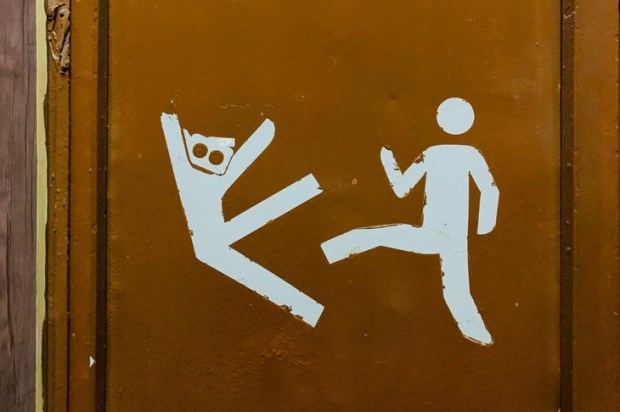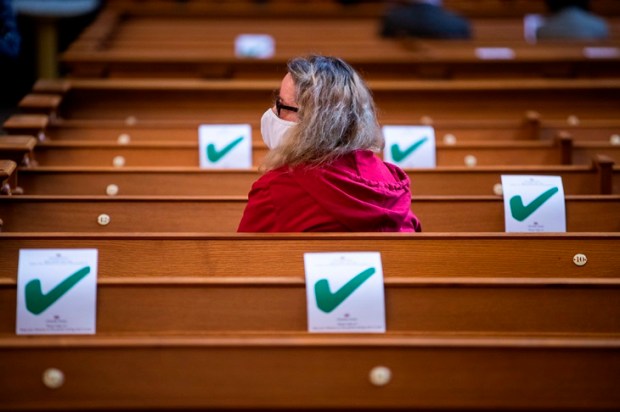Somewhere I have a couple of neat letters from the artist Richard Chopping, politely declining my requests to interview him about Ian Fleming. ‘Dicky’ is best known for the trompe l’oeil dust jackets he painted for nine of Fleming’s James Bond novels. Because of this patronage, an accomplished second-division artist gained wider prominence, becoming at one stage, according to the New Yorker, the world’s highest paid book designer.
It didn’t make him happy. He was involved in a long, bickering relationship with his fellow artist Denis Wirth-Miller, who was wilder and more experimental, but whose reputation, despite a close working association with Francis Bacon, has not endured so well.
Chopping and Wirth-Miller were a couple of sociable gay painters who flitted through various phases of British art for more than 50 years from the mid-1930s. They knew everyone, from Nina Hamnett and denizens of the clubs and pubs of Fitzrovia and Soho, through the irrepressible Bacon and Lucian Freud, to David Hockney and Zandra Rhodes, who befriended Chopping when, in later life, he taught her at the Royal College of Art.
They settled during the war at the Storehouse in Wivenhoe, Essex, where their bohemian lifestyle was legendary (Bacon would travel the 75 miles from London by taxi). Although hugely promiscuous, they eventually committed themselves to each other in one of Britain’s first civil partnerships in 2005, shortly before their deaths.
Their friend Jon Lys Turner tackles their story perceptively, though, as one of their two executors, he is perhaps too close for total objectivity. His title The Visitors’ Book provides a clue. It refers to the record of all who stayed at the Storehouse. Perhaps inevitably with this kind of biography, Lys Turner occasionally resorts to breathy lists of supporting characters, like the one Chopping kept of his sexual conquests.
During the war, when the two were particularly sexually active, they snipped buttons off their conquests’ uniforms. Lys Turner found a tin box containing 200 servicemen’s buttons (replicas of which the publisher has, bizarrely, sent out with the press pack for this book).
The narrative zips along, providing an excellent social history of gay life in the 20th century, from Chopping’s unrequited schoolboy crush on John Gielgud, through Wirth-Miller’s imprisonment for homosexuality during the war, and the strange mixture of furtiveness and licence over the following two decades, to the liberalisation of the law (Wirth-Miller was not in favour, preferring a sense of transgression) and the couple opting for civil partnership late in life.
It’s also a lively commentary on modern British art and culture. Frances Partridge, one of the last members of the Bloomsbury set, was a great friend, who would entrust her troubled son Burgo to the two artists’ care. She was devoted to Chopping, while Wirth-Miller stayed close to Bacon. Lys Turner untangles these dynamics, while drawing out the pathos and often cruelty of the bonds between the two central figures.
While the more introverted Chopping later found an outlet for his macabre imagination in the cult gay novel The Fly, Wirth-Miller enjoyed more modest success with his landscapes, until, almost to his chagrin, they were taken up and popularised by the interior designer David Hicks.
Along the way, Lys Turner serves up entertaining yarns, such as Randolph Churchill’s rudeness when he asked both artists to paint commemorative roses for his parents’ golden wedding anniversary. Chopping himself gets drunk and abusive when the Queen visits the Royal College of Art. And he was accosted by journalists as a result of his friendship with Guy Burgess, who had recently defected to the Soviet Union.
Chopping’s communications with Fleming are a constant theme. The two men were introduced by the latter’s wife Ann, who knew Bacon and Freud. Fleming liked Chopping’s output, declaring that ‘no one in the history of thrillers has had such a totally brilliant artistic collaborator’. He paid handsomely, but there were disagreements — glossed over here — about the ownership and copyright of the artwork, so disappointingly none of Chopping’s Bond novel covers are included among the illustrations. Chopping was left bearing a grudge and fending off requests from would-be biographers of Fleming and Bacon.
The post Lives of gay abandon appeared first on The Spectator.
Got something to add? Join the discussion and comment below.
Get 10 issues for just $10
Subscribe to The Spectator Australia today for the next 10 magazine issues, plus full online access, for just $10.
You might disagree with half of it, but you’ll enjoy reading all of it. Try your first month for free, then just $2 a week for the remainder of your first year.

























Comments
Don't miss out
Join the conversation with other Spectator Australia readers. Subscribe to leave a comment.
SUBSCRIBEAlready a subscriber? Log in